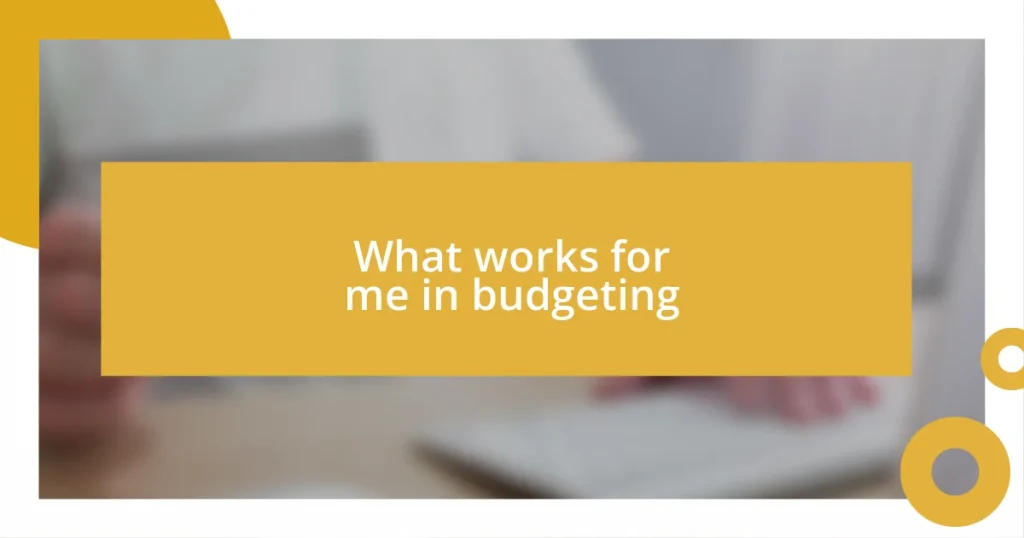Key takeaways:
- Budgeting is an empowering tool that helps identify spending patterns, prioritize joy, and set clear financial goals for future security.
- Tracking income and expenses enhances financial control by revealing spending habits, using methods like apps or dedicated time for monitoring.
- Flexibility and regular reviews are essential in budgeting, allowing adjustments in response to life’s unpredictability while maintaining focus on financial goals.

Understanding personal budgeting
Understanding personal budgeting begins with recognizing that it’s more than just tracking expenses. It’s about creating a roadmap for your financial journey, tailored specifically to your life. When I first started budgeting, I felt overwhelmed, fearing I would have to give up the little things I enjoyed. Can you relate?
As I dug deeper, I realized budgeting is an empowering tool. It helped me identify my spending patterns and prioritize what truly brought me joy—like weekend outings versus impulse buys on fancy coffee. This shift in perspective was enlightening; suddenly, budgeting felt like an ally rather than a chore. Have you ever felt that tug-of-war between saving money and enjoying life?
The emotional aspect of budgeting is significant. I remember the relief I felt when I finally set clear financial goals. They gave me something to strive for, turning budgeting into a motivating challenge rather than a necessary evil. It’s not just about numbers; it’s about freedom and security for the future. How do you envision your financial future, and could budgeting help you get there?

Setting realistic financial goals
Setting realistic financial goals is crucial for maintaining motivation in your budgeting journey. I remember when I set my first financial goal: saving for a vacation. Initially, it felt daunting, but breaking it down into smaller monthly targets made it achievable. It’s like climbing a mountain—step by step, I felt the excitement build as I got closer to my goal, making the process enjoyable rather than intimidating.
Another important aspect is ensuring that your goals are time-bound and specific. When I aimed to save $1,000 within six months, it felt much more tangible compared to just saying, “I want to save money.” This clarity made not only my approach to spending clearer, but also gave me a sense of urgency. When it comes to financial ambitions, have you ever found clarity can enhance your focus?
Lastly, flexibility is key. Life happens, and I learned that adjusting my goals doesn’t mean failure. For example, there was a month when unexpected car repairs drained my savings plan. Instead of abandoning my goal entirely, I tweaked my target and extended my timeline. This adaptability kept me in the game and reinforced the idea that budgeting can evolve as my circumstances do.
| Type of Goal | Characteristics |
|---|---|
| Short-Term Goals | Specific, achievable within a year, often involve occasional expenses. |
| Medium-Term Goals | Generally span one to five years, require consistent savings. |
| Long-Term Goals | Spanning over five years, these goals often involve major investments, like buying a house or retirement savings. |

Tracking your income and expenses
Tracking your income and expenses is a vital pillar in effective budgeting. When I first began monitoring my finances, I started by simply jotting everything down—every paycheck, every coffee run, every unexpected expense. I remember the first month I did this; the realization of just how much I spent on takeout was both shocking and eye-opening. It’s amazing how visibility can shift your perspective, revealing spending habits I hadn’t even fully recognized before.
To get started with tracking, here are some practical steps I’ve found helpful:
- Choose a method: Use apps like Mint or GoodBudget, or stick with old-school spreadsheets and notebooks—whatever feels right for you.
- Set dedicated tracking time: I found that reviewing my expenses every Sunday evening helps me stay accountable and prepare for the week ahead.
- Categorize your expenses: Breaking down my spending into categories like groceries, entertainment, and savings helped me identify where I could cut back.
- Stay consistent: The more regularly I tracked my income and expenses, the more naturally it became part of my routine.
By making tracking a priority, I could proactively adjust my spending, leading to a greater sense of control over my finances. Each month, I’d feel a little rush of accomplishment as I watched my savings grow. Have you ever felt that rewarding sense of clarity when you see your financial picture come into focus?

Implementing the envelope system
Implementing the envelope system transformed my approach to budgeting in ways I never anticipated. Initially, I was skeptical—could a bunch of envelopes really change my financial habits? But once I committed to the process, I felt an immediate shift. Each envelope represented a specific category, whether it was groceries, entertainment, or savings, and once that envelope was empty, I learned to pause and reflect before reaching for my wallet again.
I vividly remember the month I decided to challenge myself with a dining-out envelope. By allocating a fixed amount, I started to explore creative cooking at home, which not only saved me money but also turned dining into a fun experience with friends and family. Have you ever tried to turn constraints into creativity? It’s fascinating how limitations can sometimes spark innovation!
As I continued using the envelope system, I started developing a palpable sense of control over my spending. The visible cash became a tangible reminder of my financial goals. I could physically feel the weight of my decisions: if I chose to go out to dinner, I was also choosing not to put that money toward my savings. This conscious choice kept me engaged and made the act of budgeting feel less like a chore and more like an empowering exercise in self-discipline.

Using budgeting apps effectively
Using budgeting apps effectively can genuinely enhance your financial management. I remember when I first embraced an app like YNAB (You Need A Budget); it felt like my finances had been simplified and organized in ways I never thought possible. The power of having everything at my fingertips made it easy to see not only where my money was going but also how much I could allocate for fun without compromising my savings goals. Have you felt that kind of relief when you know exactly where you stand financially?
To get the most out of these apps, I recommend customizing your categories to reflect your spending habits genuinely. When I tailored my categories to include things like “Travel Fund” and “Spontaneous Treats,” I found it easy to stay motivated and even excited about budgeting! It’s incredible how a little personalization can turn numbers on a screen into a roadmap toward my dreams. If you haven’t done so yet, why not explore your own categories? What passions or goals could you bring to life through better budgeting?
Another tip that worked wonders for me is setting notifications. The reminders helped keep me accountable without being intrusive. For instance, receiving a gentle nudge when I was nearing my budget limit for entertainment prompted me to think twice before splurging. It’s amazing how a simple alert can spark that moment of reflection. Have you ever experienced that hesitation that leads to smarter financial decisions? Embracing these digital tools can transform budgeting from a bland chore into a purposeful and engaging experience.

Reviewing and adjusting your budget
Monitoring and adapting my budget is a crucial step I’ve learned to embrace wholeheartedly. At first, I used to think of my budget as a rigid plan that simply dictated my financial actions. However, over time, I discovered the value in regularly reviewing my spending and making adjustments. After all, life is unpredictable—don’t you think it’s essential to remain flexible?
I recall a month where unexpected car repairs drained a significant chunk of my budget. Instead of feeling defeated, I took that opportunity to reassess my priorities. By slicing a bit from my entertainment category, I could accommodate the necessary expenses without derailing my financial goals. This experience taught me that budgeting is not just about sticking to a plan; it’s about dynamic living and responding to challenges as they arise.
What I’ve found particularly helpful is setting aside time each month for this review. It feels empowering to look back, see where I excelled, and identify areas for improvement. Sometimes I jot down my thoughts in a journal, reflecting on what worked well and how my spending aligns with my goals. Have you ever taken a moment to really analyze your choices? It’s enlightening to witness how far you’ve come and inspires you to keep moving forward.














